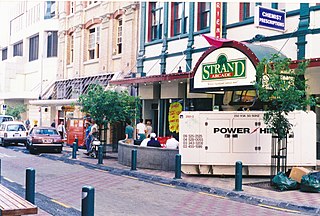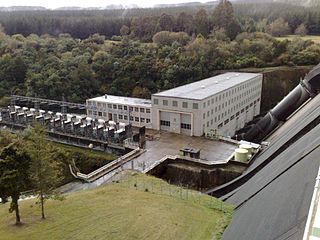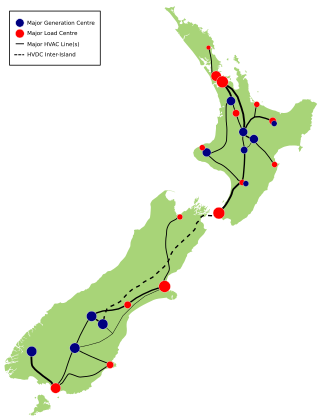Related Research Articles
Transpower New Zealand Limited (TPNZ) is the state-owned enterprise responsible for electric power transmission in New Zealand. It performs two major functions in the New Zealand electricity market. As the owner of the National Grid it provides the infrastructure of electric power transmission that allows consumers to have access to generation from a wide range of sources, and enables competition in the wholesale electricity market; as system operator it manages the real-time operation of the grid and the physical operation of the electricity market.

A substation is a part of an electrical generation, transmission, and distribution system. Substations transform voltage from high to low, or the reverse, or perform any of several other important functions. Between the generating station and consumer, electric power may flow through several substations at different voltage levels. A substation may include transformers to change voltage levels between high transmission voltages and lower distribution voltages, or at the interconnection of two different transmission voltages. They are a common component of the infrastructure. There are 55,000 substations in the United States.
The HVDC Inter-Island link is a 610 km (380 mi) long, 1200 MW high-voltage direct current (HVDC) transmission system connecting the electricity networks of the North Island and South Island of New Zealand together. It is commonly referred to as the Cook Strait cable in the media and in press releases, although the link is much longer than its Cook Strait section. The link is owned and operated by state-owned transmission company Transpower New Zealand.

Haywards is a small hillside suburb in the Hutt Valley near Wellington, New Zealand. It is notable for its large electrical substation, which is the main switching point for the Wellington region, and the home of the North Island converter station for the HVDC Inter-Island, which links the North and South Island electricity networks together.

The 1998 Auckland power crisis was a five-week-long power outage affecting the central city of Auckland, New Zealand from 19 February to 27 March 1998. A 1998 ministerial inquiry criticised both the Auckland Electric Power Board and its privatised successor, which had halved its staff after taking over in October 1993. The report blamed risk and asset management and contingency planning, but said reviews of the electricity network were in accordance with industry practice. However, Mercury Energy’s Board had known for 5 years of a potential failure of the power cables, but, instead of also replacing them, took the cost-saving risk of only building a replacement tunnel, which wasn't ready in time. The inquiry report also said, "Internal expertise in 110 kV assets was not maintained at a sufficient level".

Vector Limited is a New Zealand energy company, which runs a portfolio of businesses delivering energy and communication services across Australasia and the Pacific. Its primary business is electricity distribution, along with distributing piped gas. It also has a bottled gas business, owns a fibre optic cable network, deploys electricity and gas meters, manages solar infrastructure projects and offers cybersecurity services and a data platform. It is also the parent company of HRV ventilation solutions.

The Huntly Power Station is the largest thermal power station in New Zealand and is located in the town of Huntly in the Waikato. It is operated by Genesis Energy Limited, a publicly listed company. The station has five operational generating units – three 250 MW coal-and-gas-fired steam turbine units, a 50 MW gas peaking plant, and a 403 MW combined cycle gas turbine plant. The station also plays an important role in voltage support for the Northland, Auckland and Waikato regions.
The Poatina Power Station is a conventional hydroelectric power station located in the Central Highlands region of Tasmania, Australia. The power station is situated on the Great Lake and South Esk and is owned and operated by Hydro Tasmania.
The electricity sector in New Zealand uses mainly renewable energy, such as hydropower, geothermal power and increasingly wind energy. As of 2019, 82% of electricity is generated from renewable sources, making New Zealand one of the countries with the lowest carbon dioxide emissions from electricity generation. Electricity demand grew by an average of 2.1% per year from 1974 to 2010 but decreased by 1.2% from 2010 to 2013.

An electrical grid is an interconnected network for electricity delivery from producers to consumers. Electrical grids consist of power stations, electrical substations to step voltage up or down, electric power transmission to carry power long distances, and lastly electric power distribution to individual customers, where voltage is stepped down again to the required service voltage(s). Electrical grids vary in size and can cover whole countries or continents. From small to large there are microgrids, wide area synchronous grids, and super grids.

Whakamaru Power Station is a hydroelectric power station on the Waikato River, in the North Island of New Zealand. It is the fourth hydroelectric power station on the Waikato River.

The National Grid is the nationwide system of electric power transmission in New Zealand. The grid is owned, operated and maintained by Transpower New Zealand, a state-owned enterprise, although some lines are owned by local distribution companies and leased to Transpower. In total, the national grid contains 11,803 kilometres (7,334 mi) of high-voltage lines and 178 substations.
The Trans Bay Cable is a high-voltage direct current (HVDC) underwater transmission cable interconnection between San Francisco, California and Pittsburg, California. The 53 mi (85 km) cable under San Francisco Bay and through the Carquinez Strait can transmit 400 megawatts of power at a DC voltage of ±200 kV, enough to provide 40% of San Francisco's peak power needs.

The Whakamaru to Brownhill Road transmission line is a double-circuit 400 kV-capable transmission line constructed by Transpower to increase the capacity of the National Grid between the southern Waikato and the city of Auckland. The line runs from the Whakamaru sub-station near the Whakamaru Power Station, over a distance of 186 kilometres (116 mi) to the new Brownhill Road substation near Whitford in southeastern Auckland. The line will initially be operated at 220 kV. From Brownhill Road, 220 kV underground cables connect the line to the Pakuranga sub-station in eastern Auckland. The project was the subject of considerable controversy and protest during the planning and approval stages. Construction of the line started in February 2010, and the line was commissioned on 30 October 2012. The transmission line forms the major part of a wider North Island Grid Upgrade project with a forecast cost to completion of $894 million.

Hradec substation is a collector substation connecting the 220 kV and 400 kV grid in the Czech Republic's electricity grid. It is situated in Rokle near its local part Hradec in the Ústí nad Labem Region.

The 2011 Southwest blackout, also known as the Great Blackout of 2011, was a widespread power outage that affected the San Diego–Tijuana area, southern Orange County, Imperial Valley, Mexicali Valley, Coachella Valley, and parts of Arizona. It occurred on Thursday, September 8, 2011, beginning at about 3:38pm PDT, and was the largest power failure in California history.
The North Auckland and Northland (NAaN) grid upgrade project reinforced transmission into the Auckland Region and across the harbour to North Auckland and the Northland Region. It added new 220 kV transmission capacity to the National Grid by providing 37 km of underground cable between the Pakuranga, Penrose, and Albany substations.

Electricity Ashburton Limited, trading as EA Networks is a co-operatively-owned electricity distribution company, based in Ashburton, New Zealand.
The Heywood interconnector is a 275 kV AC overhead electricity transmission line with two circuits connecting the electricity grids in South Australia and Victoria, two states of Australia. Both are part of the National Electricity Market. The nominal capacity of the interconnector is 650 MW since an upgrade in 2016. The interconnector was commissioned in 1988 and was the first connection between the two state electricity grids.
References
- ↑ Johnston, Martin (16 April 2018). "A crisis recalled: The power cuts that plunged the Auckland CBD in darkness for five weeks". New Zealand Herald. Archived from the original on 5 August 2019. Retrieved 1 September 2022.
- ↑ Field, Michael; Walters, Laura (6 October 2014). "Auckland's history of power cuts". Stuff. Archived from the original on 16 May 2019. Retrieved 1 September 2022.
- ↑ "Transpower Announces Reports on Auckland Power Outage in June". Transmission & Distribution World. 11 July 2006. Archived from the original on 22 November 2008. Retrieved 5 February 2009.
- ↑ "INCIDENT REVIEW – OTAHUHU SUBSTATION LOSS OF SUPPLY 12TH JUNE 2006" (PDF). Sinclair Knight Merz. 23 June 2006. Archived (PDF) from the original on 30 September 2011. Retrieved 26 July 2011.
- ↑ Connell Wagner (5 July 2006). "Review of Report on Auckland Transmission Outage of 12 June 2006". Archived from the original on 15 October 2008. Retrieved 5 February 2009.
- ↑ "Otahuhu substation diversity proposal – Final decision, Electricity Commission". Archived from the original on 1 April 2012. Retrieved 25 September 2011.